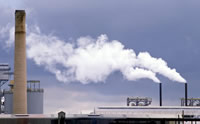
Air permits are divided into construction permits and operating permits.
- Construction permits are usually required when building a new facility or installing and/or modifying a process or piece of equipment. The construction permit defines the air pollution source, establishes emissions limits and indentifies the equipment and/or controls to meet those limits. Applicants must apply for and obtain construction permits before initiating construction activities.
- Operating permits are required after construction is complete and govern the operation of the source, including control devices, to ensure ongoing compliance with applicable air regulations. In many instances, the operating permit application process can be concurrent with the construction permit to avoid delays initiating operation of the source.
Both construction permits and operating permits can be classified into major source and nonmajor source air permits. Major sources are those sources that have the potential to emit air pollutants above thresholds established in the air regulations for each type of air permit. Major source construction permits are referred to as new source review (NSR) permits. Major source operating permits are known as Title V permits.
Forget expensive calls to lawyers and consultants. With Enviro.BLR.com, you get instant access, 24/7. Try it out today and get the 2011-2012 EHS Salary Guide, absolutely free. Download Your Free Report
The NSR permit requirements depend on whether the ambient air quality in areas where the source is located meets the National Ambient Air Quality Standards (NAAQS). Sources located in areas that do not meet one or more of the NAAQS (i.e., a nonattainment area) must comply with nonattainment NSR requirements for the given nonattainment pollutant. Sources located in areas that meet the NAAQS (i.e., attainment areas), must comply with the requirements of Prevention of Significant Deterioration (PSD) for the given pollutants.
The major source thresholds for nonattainment NSR and PSD differ, as do the level of emissions controls required and other permitting requirements. In many cases a source will have to comply with nonattainment NSR for one pollutant and PSD for other pollutants within single major source construction permit.
Title V permits are intended to facilitate compliance by consolidating all the applicable requirements for all the sources located at a facility in one document, as opposed to multiple construction and/or operating permits accumulated over time as emissions units are added or modified. The Title V permit does not establish any new emissions limits, but it may establish monitoring, recordkeeping and reporting requirements to ensure ongoing compliance and documentation of such compliance.
The NSR and Title V regulations are established by EPA at the federal level. However, most states and local regulatory agencies, where applicable, adopt regulations that follow and are at least as stringent as the federal requirements. Therefore, state and local regulatory agencies usually administer the major source permitting programs.
Forget expensive calls to lawyers and consultants. With Enviro.BLR.com, you get instant access, 24/7. Try it out today and get the 2011-2012 EHS Salary Guide, absolutely free. Download Your Free Report
In addition, air regulations for nonmajor source construction and operating permits are established and administered by state and local regulatory agencies. Such agencies may establish emissions thresholds below which air permits are not required and other exemptions from air permitting requirements. Nonmajor source construction and operating permits are often combined into a single permit.
So where do you begin? Any time a new source or a modification to an existing source of air pollution is being considered, one of the first steps is to calculate the potential emissions from source and the whole facility. The quantity of air pollutant emissions along with the location of the source and the attainment/nonattainment status of the air quality in the area will help determine what air permitting regulations will apply.

1 thought on “Air Permits: Where Do You Begin?”